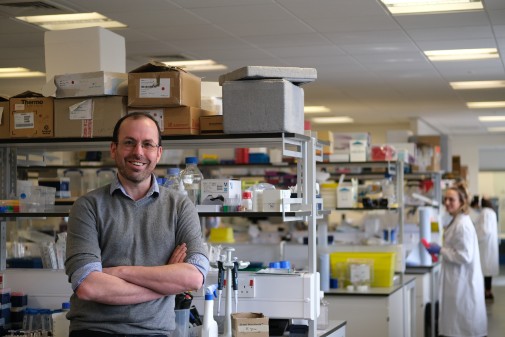Researchers shed new light on how immune cells acquire mutations which can develop into cancer
Posted on 12 August 2022
 Dr David Kent from the Department of Biology and York Biomedical Research Institute at the University of York.
Dr David Kent from the Department of Biology and York Biomedical Research Institute at the University of York.
The findings could help shed light on why some cells go on to develop into cancer, particularly in some blood cancers.
In the study, researchers from the University of York, the Wellcome Sanger Institute, and collaborators grew and sequenced colonies of immune cells – lymphocytes known as B- and T-cells – from a single cell.
Published in Nature, the research found that the mutations seen in healthy B cells were largely similar to those seen in cancerous B-cells, suggesting that the development of cancer arises from the same mutational processes. Understanding more about the factors that cause these mutations to develop into cancer in some cells and not others could help shed light on the origins of the disease.
Lymphoma
Cancer of the immune cells is known as lymphoma – a group of cancers including non-Hodgkin’s lymphoma – impacts more than 13,000 people in the UK per year.
While cancer can develop at any point in a person’s life, age can be a risk factor in some types of cancer as over time these cells acquire more genetic mutations, with some of these mutations giving a higher risk of developing cancer.
Understanding
Co-senior author of the research, Dr David Kent from the Department of Biology and York Biomedical Research Institute at the University of York, said: “Our research suggests that even though lymphocytes play the same role throughout the body, the mutations that they acquire are linked to their specific tissue environments. These environments could play a larger role in the development of certain lymphomas than inherited mutations.
"Understanding these processes in greater detail may be able to help shed light on why some of these cells go on to develop into cancer, while others don’t.”
B-cells and T-cells are part of the adaptive immune system. They undergo a certain amount of genetic mutation in order to be able to recognise and fight off pathogens. The scientists found that while this normal genetic mutation is mostly well targeted to the genes for antibodies, a surprising amount of collateral damage occurs elsewhere in the genome – it is this off-target mutation that can lead to lymphocytes becoming cancerous.
In addition, as lymphocytes spread through the body to survey for infections, they are exposed to additional DNA damaging agents, which can further increase the number of mutations.
Patterns
The team sequenced genomes from over 700 normal immune cells across seven donors, with ages from 0 to 81 years. They found that the number and patterns of mutations in B-cells and T-cells varied extensively from cell to cell.
The considerably greater cell-to-cell variation than person-to-person variation suggests that changes within different areas of the body over a person’s lifetime, such as certain infections and inflammation, are more likely to cause mutations linked with cancer and disease than inherited mutations in genes.
The research gives more in-depth insight into the mutational landscape of healthy lymphocytes and the processes that cause these mutations, which adds to the current understanding of ageing. Further research into how much these mutations and processes vary between tissues is needed to investigate if these offer any avenues for future treatment.
Impact
Dr Heather Machado, first author from the Wellcome Sanger Institute, said: “The adaptive immune system changes a lot as we age, but previously it has not been possible to study this in the same level of detail as we have achieved here. Our research is another step towards understanding how mutations in lymphocytes accumulate over time and the impact that these have on the ageing process. The protocol we have developed in order to expand cells can also be applied to other areas of research, and we hope that it will be as valuable to other scientists as it is to us.”
Dr Peter Campbell, co-senior author from the Wellcome Sanger Institute, added: “Our research begins to fill in the missing gaps in knowledge around how mutations in the adaptive immune system feed into ageing. By sequencing around 700 lymphocyte genomes, we have started to build a better picture of the mutational processes that happen over time, and how this relates to the development of lymphoma. While more research is needed, this research gives a strong foundation for further studies into this area.”
Explore more news

New butterfly species created 200,000 years ago by two species interbreeding
Thursday 18 April 2024

Children in the North at greater risk of entering care
Wednesday 17 April 2024

Boreal forest and tundra regions worst hit over next 500 years of climate change, study shows
Monday 8 April 2024

Researchers developing ultra-sensitive blood test with potential to revolutionise diagnosis of Alzheimer’s
Thursday 4 April 2024

Attitudes to being an adult are shifting as traditional milestones become out of reach, new study finds
Wednesday 27 March 2024
Media enquiries
About this research
Diverse mutational landscapes in human lymphocytes is published in the journal Nature
